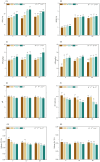Co-application of biochars and Piriformospora indica improved the quality of coastal saline soil and promoted the growth of forage
- PMID: 39188547
- PMCID: PMC11345218
- DOI: 10.3389/fpls.2024.1434097
Co-application of biochars and Piriformospora indica improved the quality of coastal saline soil and promoted the growth of forage
Abstract
Soil quality is defined as the ability of soil to maintain the soil environment and the biosphere. Due to the limitation of salt and alkali stress, soil quality can be reduced, which in turn affects agricultural production. Biochar is widely used in saline-alkali land improvement because of its special pore structure and strong ion exchange ability, while Piriformospora indica is widely used in saline-alkali land improvement because it can symbiose with plants and improve plant stress resistance. However, the synergistic effect of combined biochar application and inoculation of P. indica on the quality of saline-alkali soil and plant development is uncertain. Hence, we investigated the combined influences of biochar and P. indica on the soil physicochemical characteristics, as well as the growth and chlorophyll florescence of sorghum-sudangrass hybrids (Sorghum bicolor × Sorghum sudane) in our study. The results indicated that after applying biochar and P. indica together, there was a considerable drop in soil pH, conductivity, Na+, and Cl- concentrations. Meanwhile, the soil organic matter (SOM), available phosphorus (AP), and alkaline hydrolyzable nitrogen (AN) increased by 151.81%, 50.84%, and 103.50%, respectively, when the Bamboo biochar was combined with 120 ml/pot of P. indica. Eventually, sorghum-sudangrass hybrid biomass, transpiration rate, and chlorophyll content increased by 111.69%, 204.98%, and 118.54%, respectively. According to our findings, using P. indica and biochar together can enhance soil quality and plant growth. The results also provide insights to enhance the quality of saline-alkali soils and the role of microorganisms in nutrient cycling.
Keywords: Piriformospora indica; biochar; forage; photosynthesis; saline-alkali soil.
Copyright © 2024 Wu, Ning, Liu, Zheng, Li, Li, Zhou, Li, Li, Zhang and Dong.
Conflict of interest statement
The authors declare that the research was conducted in the absence of any commercial or financial relationships that could be construed as a potential conflict of interest.
Figures





References
-
- Babu A. G., Shim J., Shea P. J., Oh B. T. (2014). Penicillium aculeatum PDR-4 and Trichoderma sp. PDR-16 promote phytoremediation of mine tailing soil and bioenergy production with Sorghum-Sudangrass. Ecol. Engineering. 69, 186–191. doi: 10.1016/j.ecoleng.2014.03.055 - DOI
LinkOut - more resources
Full Text Sources

